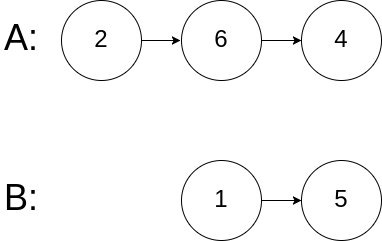160. Intersection of Two Linked Lists
Easy
Write a program to find the node at which the intersection of two singly linked lists begins.
For example, the following two linked lists:

begin to intersect at node c1.
Example 1:

Input: intersectVal = 8, listA = [4,1,8,4,5], listB = [5,0,1,8,4,5], skipA = 2, skipB = 3 Output: Reference of the node with value = 8 Input Explanation: The intersected node's value is 8 (note that this must not be 0 if the two lists intersect). From the head of A, it reads as [4,1,8,4,5]. From the head of B, it reads as [5,0,1,8,4,5]. There are 2 nodes before the intersected node in A; There are 3 nodes before the intersected node in B.
Example 2:

Input: intersectVal = 2, listA = [0,9,1,2,4], listB = [3,2,4], skipA = 3, skipB = 1 Output: Reference of the node with value = 2 Input Explanation: The intersected node's value is 2 (note that this must not be 0 if the two lists intersect). From the head of A, it reads as [0,9,1,2,4]. From the head of B, it reads as [3,2,4]. There are 3 nodes before the intersected node in A; There are 1 node before the intersected node in B.
Example 3:

Input: intersectVal = 0, listA = [2,6,4], listB = [1,5], skipA = 3, skipB = 2 Output: null Input Explanation: From the head of A, it reads as [2,6,4]. From the head of B, it reads as [1,5]. Since the two lists do not intersect, intersectVal must be 0, while skipA and skipB can be arbitrary values. Explanation: The two lists do not intersect, so return null.
Notes:
- If the two linked lists have no intersection at all, return
null. - The linked lists must retain their original structure after the function returns.
- You may assume there are no cycles anywhere in the entire linked structure.
- Your code should preferably run in O(n) time and use only O(1) memory.
package leetcode.easy;
/**
* Definition for singly-linked list. public class ListNode { int val; ListNode
* next; ListNode(int x) { val = x; next = null; } }
*/
public class IntersectionOfTwoLinkedLists {
public ListNode getIntersectionNode(ListNode headA, ListNode headB) {
if (null == headA || null == headB) {
return null;
} else {
ListNode pA = headA;
ListNode pB = headB;
while (pA != pB) {
if (pA != null) {
pA = pA.next;
} else {
pA = headB;
}
if (pB != null) {
pB = pB.next;
} else {
pB = headA;
}
}
return pA;
}
}
@org.junit.Test
public void test0() {
ListNode a1 = new ListNode(1);
ListNode a2 = new ListNode(2);
ListNode b1 = new ListNode(1);
ListNode b2 = new ListNode(2);
ListNode b3 = new ListNode(3);
ListNode c1 = new ListNode(1);
ListNode c2 = new ListNode(2);
ListNode c3 = new ListNode(3);
a1.next = a2;
b1.next = b2;
b2.next = b3;
a2.next = c1;
b3.next = c1;
c1.next = c2;
c2.next = c3;
c3.next = null;
System.out.println(getIntersectionNode(a1, b1).val);
}
@org.junit.Test
public void test1() {
ListNode a1 = new ListNode(4);
ListNode a2 = new ListNode(1);
ListNode b1 = new ListNode(5);
ListNode b2 = new ListNode(0);
ListNode b3 = new ListNode(1);
ListNode c1 = new ListNode(8);
ListNode c2 = new ListNode(4);
ListNode c3 = new ListNode(5);
a1.next = a2;
b1.next = b2;
b2.next = b3;
a2.next = c1;
b3.next = c1;
c1.next = c2;
c2.next = c3;
c3.next = null;
System.out.println(getIntersectionNode(a1, b1).val);
}
@org.junit.Test
public void test2() {
ListNode a1 = new ListNode(0);
ListNode a2 = new ListNode(9);
ListNode a3 = new ListNode(1);
ListNode b1 = new ListNode(3);
ListNode c1 = new ListNode(2);
ListNode c2 = new ListNode(4);
a1.next = a2;
a2.next = a3;
a3.next = c1;
b1.next = c1;
c1.next = c2;
c2.next = null;
System.out.println(getIntersectionNode(a1, b1).val);
}
@org.junit.Test
public void test3() {
ListNode a1 = new ListNode(2);
ListNode a2 = new ListNode(6);
ListNode a3 = new ListNode(4);
ListNode b1 = new ListNode(1);
ListNode b2 = new ListNode(5);
a1.next = a2;
a2.next = a3;
a3.next = null;
b1.next = b2;
b2.next = null;
System.out.println(getIntersectionNode(a1, b1));
}
}